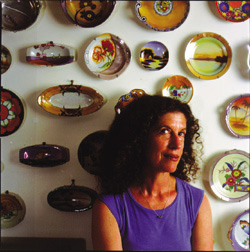Collective
efforts
>>
In
the kitschen
The
best thing about their collection of 500 ceramic cow creamers,
say Barry Skovgaard, JD'80, and Marc Wolinsky, JD'80, is that
it isn't-technically-theirs. "We get all the satisfaction
of collecting without the burden of owning, cleaning, holding,
and storing the things," claims Skovgaard, straight-faced,
even though one-third of the herd (a sugar-and-creamer subcollection)
sits in his Manhattan office and another third grazes in the apartment
he shares with Wolinsky. The collection, they insist, belongs
to Wolinsky's sister, Toni, who keeps the rest in her Haworth,
New Jersey, home.

The
first creamer, purchased at a yard sale in the mid-1980s, was
a gag gift for Toni. By the end of the 1980s, the couple threw
her a "Night of the 100th Cow" party. When she completed
her Ph.D. in 1989, they spared no expense: her Tiffany & Co.
creamer, she says, is "very classy" and the one she
would grab if disaster struck. Skovgaard, meanwhile, is partial
to "Toni's" subcollection of souvenir cows. Branded
on their haunches are images of Dollywood, Lake George, Niagara
Falls.
Barbara
Siegel, AB'69, is also partial to Niagara kitsch. The Falls silently
roar on 11 of the 200 hand-painted decorative lustre-ware plates
from the 1930s and 1940s mounted in her Tribeca loft kitchen.
There are nut plates and platters, floral designs and geometric
patterns, and of course, quirky souvenir plates with stylized
and impressionistic scenes from Yellowstone, the Egyptian pyramids,
and Little America, Wyoming. "My collection is based on the
eccentricities of the plates," says Siegel, a found-object
artist and teacher whose accumulation of salt-and-pepper shakers
from the same era vies for her affection. "I collect intuitively,"
she continues-and frugally. She never pays more than $25 for a
plate. "And that's very high."

Half
a continent away in Iowa City, Iowa, another frugal kitchen kitsch
collector, Elizabeth Stege Huttner, AM'76, has assembled 40 embossed
aluminum hot pads for $18 apiece or less. Souvenirs from world's
fairs, international expositions, national parks, and tourist
sites, nearly all of Huttner's hot pads were manufactured by Sayford
Co. of Brooklyn or C. A. Brewer & Sons of Chicago. Her collecting
urge was sparked by memories of her grandmother's hot pads. "I
had always thought they were so much more interesting than the
cotton-loop pot holders that my sisters and I churned out and
the rest of the family dutifully used."
Huttner
is quick to distinguish herself from more avid collectors like
her husband (see "Collected Works," p. 29), though she
admits there was a plate that got away. "A fantastic hot
pad from a Houston oil exposition. Unfortunately, the Texas connection
made the bidding too rich for me. But I still hope to find one
some day."

![]()

